High Dielectric Design of Polymer Composites by Using Artificial Neural Network
Abstract
:1. Introduction
2. Materials and Methods
2.1. Data Collection and Model Variables Description
2.2. Development and Optimization the ANN Model
3. Results & Discussions
3.1. Training of the ANN Model
3.2. Correlation Analysis of Variables
3.3. Influence of Variables on Dielectric Constant
3.3.1. Effect of Filler Dimension
3.3.2. Effect of Operating Frequency
4. Conclusions
Author Contributions
Funding
Institutional Review Board Statement
Informed Consent Statement
Data Availability Statement
Conflicts of Interest
References
- Huan, T.D.; Boggs, S.; Teyssedre, G.; Laurent, C.; Cakmak, M.; Kumar, S.; Ramprasad, R. Advanced polymeric dielectrics for high energy density applications. Prog. Mater. Sci. 2016, 83, 236–269. [Google Scholar] [CrossRef]
- Chen, J.; Wang, Y.; Xu, X.; Yuan, Q.; Niu, Y.; Wang, Q.; Wang, H. Ultrahigh discharge efficiency and energy density achieved at low electric fields in sandwich-structured polymer films containing dielectric elastomers. J. Mater. Chem. A 2019, 7, 3729–3736. [Google Scholar] [CrossRef]
- Shen, Y.; Lin, Y.; Zhang, Q.M. Polymer nanocomposites with high energy storage densities. MRS Bull. 2015, 40, 753–759. [Google Scholar] [CrossRef]
- Liu, F.; Li, Q.; Cui, J.; Li, Z.; Yang, G.; Liu, Y.; Wang, Q. High-energy-density dielectric polymer nanocomposites with trilayered architecture. Adv. Funct. Mater. 2017, 27, 1606292. [Google Scholar] [CrossRef]
- Tang, H.; Lin, Y.; Sodano, H.A. Synthesis of high aspect ratio BaTiO3 nanowires for high energy density nanocomposite capacitors. Adv. Energy Mater. 2013, 3, 451–456. [Google Scholar] [CrossRef]
- Tang, H.; Sodano, H.A. Ultra high energy density nanocomposite capacitors with fast discharge using Ba0.2Sr0.8TiO3 nanowires. Nano Lett. 2013, 13, 1373–1379. [Google Scholar] [CrossRef]
- Tang, H.; Lin, Y.; Andrews, C.; Sodano, H.A. Nanocomposites with increased energy density through high aspect ratio PZT nanowires. Nanotechnology 2010, 22, 015702. [Google Scholar] [CrossRef]
- Das, A.; Haider, A.; Samaddar, S. An automation approach in dielectric constant prediction using machine learning. In Proceedings of the International Conference on Energy, Communication, Data Analytics and Soft Computing (ICECDS), Chennai, India, 1–2 August 2017; pp. 3084–3086. [Google Scholar]
- Kota, R.; Ali, A.F.; Lee, B.I.; Sychov, M.M. Dielectric constant of barium titanate/cyanoethyl ester of polyvinyl alcohol composite in comparison with the existing theoretical models. Microelectron. Eng. 2007, 84, 2853–2858. [Google Scholar] [CrossRef]
- Umeda, Y.; Hayashi, H.; Moriwake, H.; Tanaka, I. Prediction of dielectric constants using a combination of first principles calculations and machine learning. Jpn. J. Appl. Phys. 2019, 58, SLLC01. [Google Scholar] [CrossRef]
- Ding, C.; Yu, S.; Tang, X.; Liu, Z.; Luo, H.; Zhang, Y.; Chen, S. The design and preparation of high-performance ABS-based dielectric composites via introducing core-shell polar polymers@ BaTiO3 nanoparticles. Compos. Part A Appl. Sci. Manuf. 2022, 163, 107214. [Google Scholar] [CrossRef]
- Luo, H.; Ma, C.; Zhou, X.; Chen, S.; Zhang, D. Interfacial design in dielectric nanocomposite using liquid-crystalline polymers. Macromolecules 2017, 50, 5132–5137. [Google Scholar] [CrossRef]
- Luo, B.; Wang, X.; Wang, Y.; Li, L. Fabrication, characterization, properties and theoretical analysis of ceramic/PVDF composite flexible films with high dielectric constant and low dielectric loss. J. Mater. Chem. A 2014, 2, 510–519. [Google Scholar] [CrossRef]
- Zak, A.K.; Gan, W.C.; Majid, W.A.; Darroudi, M.; Velayutham, T.S. Experimental and theoretical dielectric studies of PVDF/PZT nanocomposite thin films. Ceram. Int. 2011, 37, 1653–1660. [Google Scholar] [CrossRef]
- Shen, Z.H.; Wang, J.J.; Jiang, J.Y.; Huang, S.X.; Lin, Y.H.; Nan, C.W.; Shen, Y. Phase-field modeling and machine learning of electric-thermal-mechanical breakdown of polymer-based dielectrics. Nat. Commun. 2019, 10, 1–10. [Google Scholar] [CrossRef] [Green Version]
- Yi, Y.; Wang, L.M.; Yin, F.H. Interval support vector regression enables high-throughput machine learning predictions for dielectric constant of polymer dielectrics. Appl. Phys. Lett. 2021, 118, 223901. [Google Scholar] [CrossRef]
- Awad, N.; Mallik, N.; Hutter, F. DEHB: Evolutionary Hyperband for Scalable, Robust and Efficient Hyperparameter Optimization. arXiv 2021, arXiv:2105.09821. [Google Scholar]
- Liu, Y.; Wen, Y.; Xu, W.; Li, B.; Song, Z.; Li, Y.; Xia, F. Improving the energy density of P (VDF-HFP)/boron nitride nanosheets nanocomposites by using the third phase filler with high dielectric constant. J. Polym. Res. 2021, 28, 411. [Google Scholar] [CrossRef]
- Li, Y.; Zhou, Y.; Zhu, Y.; Cheng, S.; Yuan, C.; Hu, J.; Li, Q. Polymer nanocomposites with high energy density and improved charge-discharge efficiency utilizing hierarchically-structured nanofillers. J. Mater. Chem. A 2020, 8, 6576–6585. [Google Scholar] [CrossRef]
- Lu, X.; Zhang, L.; Tong, Y.; Cheng, Z.Y. BST-P (VDF-CTFE) nanocomposite films with high dielectric constant, low dielectric loss, and high energy-storage density. Compos. Part B Eng. 2019, 168, 34–43. [Google Scholar] [CrossRef]
- Song, Y.; Shen, Y.; Hu, P.; Lin, Y.; Li, M.; Nan, C.W. Significant enhancement in energy density of polymer composites induced by dopamine-modified Ba0.6Sr0.4TiO3 nanofibers. Appl. Phys. Lett. 2012, 101, 152904. [Google Scholar] [CrossRef]
- Hu, P.; Song, Y.; Liu, H.; Shen, Y.; Lin, Y.; Nan, C.W. Largely enhanced energy density in flexible P (VDF-TrFE) nanocomposites by surface-modified electrospun BaSrTiO3 fibers. J. Mater. Chem. A 2013, 1, 1688–1693. [Google Scholar] [CrossRef]
- Xiong, X.; Zhang, Q.; Zhang, Q.; Yang, H.; Tong, J.; Wen, J. Superior energy storage performance of PVDF-based composites induced by a novel nanotube structural BST@SiO2 filler. Compos. Part A: Appl. Sci. Manuf. 2021, 145, 106375. [Google Scholar] [CrossRef]
- Beier, C.W.; Sanders, J.M.; Brutchey, R.L. Improved breakdown strength and energy density in thin-film polyimide nanocomposites with small barium strontium titanate nanocrystal fillers. J. Phys. Chem. C 2013, 117, 6958–6965. [Google Scholar] [CrossRef]
- Liu, S.; Wang, J.; Hao, H.; Zhao, L.; Zhai, J. Discharged energy density and efficiency of nanocomposites based on poly (vinylidene fluoride) and core-shell structured BaTiO3@Al2O3 nanoparticles. Ceram. Int. 2018, 44, 22850–22855. [Google Scholar] [CrossRef]
- Hu, P.; Jia, Z.; Shen, Z.; Wang, P.; Liu, X. High dielectric constant and energy density induced by the tunable TiO2 interfacial buffer layer in PVDF nanocomposite contained with core–shell structured TiO2@BaTiO3 nanoparticles. Appl. Surf. Sci. 2018, 441, 824–831. [Google Scholar] [CrossRef]
- Ma, J.; Azhar, U.; Zong, C.; Zhang, Y.; Xu, C.; Zhang, Z.S. Core-shell structured PVDF@ BT nanoparticles for dielectric materials: A novel composite to prove the dependence of dielectric properties on ferroelectric shell. Mater. Des. 2019, 164, 107556. [Google Scholar] [CrossRef]
- Liu, S.; Zhai, J. Improving the dielectric constant and energy density of poly (vinylidene fluoride) composites induced by surface-modified SrTiO3 nanofibers by polyvinylpyrrolidone. J. Mater. Chem. A 2015, 3, 1511–1517. [Google Scholar] [CrossRef]
- Yao, M.; You, S.; Peng, Y. Dielectric constant and energy density of poly (vinylidene fluoride) nanocomposites filled with core-shell structured BaTiO3@Al2O3 nanoparticles. Ceram. Int. 2017, 43, 3127–3132. [Google Scholar] [CrossRef]
- Wang, J.; Long, Y.; Sun, Y.; Zhang, X.; Yang, H.; Lin, B. Enhanced energy density and thermostability in polyimide nanocomposites containing core-shell structured BaTiO3@SiO2 nanofibers. Appl. Surf. Sci. 2017, 426, 437–445. [Google Scholar] [CrossRef]
- Wang, M.; Li, W.L.; Feng, Y.; Hou, Y.F.; Zhang, T.D.; Fei, W.D.; Yin, J.H. Effect of BaTiO3 nanowires on dielectric properties and energy storage density of polyimide composite films. Ceram. Int. 2015, 41, 13582–13588. [Google Scholar] [CrossRef]
- Wang, J.; Sun, Y.; Wang, P.; Yu, X.; Shi, H.; Zhang, X.; Lin, B. High energy density of polyimide composites containing one-dimensional BaTiO3@ZrO2 nanofibers for energy storage device. J. Alloys Compd. 2019, 789, 785–791. [Google Scholar] [CrossRef]
- Wang, G.; Huang, X.; Jiang, P. Bio-inspired fluoro-polydopamine meets barium titanate nanowires: A perfect combination to enhance energy storage capability of polymer nanocomposites. ACS Appl. Mater. Interfaces 2017, 9, 7547–7555. [Google Scholar] [CrossRef] [PubMed]
- Xie, B.; Zhang, Q.; Zhang, H.; Zhang, G.; Qiu, S.; Jiang, S. Largely enhanced ferroelectric and energy storage performances of P (VDF-CTFE) nanocomposites at a lower electric field using BaTiO3 nanowires by stirring hydrothermal method. Ceram. Int. 2016, 42, 19012–19018. [Google Scholar] [CrossRef]
- Niu, Y.; Yu, K.; Bai, Y.; Wang, H. Effect of the modifier structure on the performance of barium titanate/poly (vinylidene fluoride) nanocomposites for energy storage applications. IEEE Trans. Ultrason. Ferroelectr. Freq. Control. 2015, 62, 108–115. [Google Scholar] [CrossRef] [PubMed]
- Pan, Z.; Ding, Q.; Yao, L.; Huang, S.; Xing, S.; Liu, J.; Zhai, J. Simultaneously enhanced discharge energy density and efficiency in nanocomposite film capacitors utilizing two-dimensional NaNbO3@Al2O3 platelets. Nanoscale 2019, 11, 10546–10554. [Google Scholar] [CrossRef] [PubMed]
- Chen, J.; Ye, D.; Wu, X.; Zhu, W.; Wang, X.; Xiao, P.; Yu, X. Large enhancement of discharge energy density of polymer nanocomposites filled with one-dimension core-shell structured NaNbO3@SiO2 nanowires. Compos. Part A Appl. Sci. Manuf. 2020, 133, 105832. [Google Scholar] [CrossRef]
- Pan, Z.; Yao, L.; Ge, G.; Shen, B.; Zhai, J. High-performance capacitors based on NaNbO3 nanowires/poly (vinylidene fluoride) nanocomposites. J. Mater. Chem. A 2018, 6, 14614–14622. [Google Scholar] [CrossRef]
- Zhang, H.; Zhu, Y.; Li, Z.; Fan, P.; Ma, W.; Xie, B. High discharged energy density of polymer nanocomposites containing paraelectric SrTiO3 nanowires for flexible energy storage device. J. Alloys Compd. 2018, 744, 116–123. [Google Scholar] [CrossRef]
- Li, J.; Seok, S.I.; Chu, B.; Dogan, F.; Zhang, F.; Wang, Q. Nanocomposites of ferroelectric polymers with TiO2 nanoparticles exhibiting significantly enhanced electrical energy density. Adv. Mater. 2009, 21, 217–221. [Google Scholar] [CrossRef]
- Wang, G.; Huang, X.; Jiang, P. Mussel-inspired fluoro-polydopamine functionalization of titanium dioxide nanowires for polymer nanocomposites with significantly enhanced energy storage capability. Sci. Rep. 2017, 7, 43071. [Google Scholar] [CrossRef]
- Ding, S.; Yu, S.; Zhu, X.; Xie, S.; Sun, R.; Liao, W.H.; Wong, C.P. Enhanced breakdown strength of polymer composites by low filler loading and its mechanisms. Appl. Phys. Lett. 2017, 111, 153902. [Google Scholar] [CrossRef]
- Wang, G.; Huang, X.; Jiang, P. Tailoring Dielectric Properties and Energy Density of Ferroelectric Polymer Nanocomposites by High-k Nanowires. ACS Appl. Mater. Interfaces 2015, 7, 18017–18027. [Google Scholar] [CrossRef] [PubMed]
- Ai, D.; Li, H.; Zhou, Y.; Ren, L.; Han, Z.; Yao, B.; Wang, Q. Tuning nanofillers in in situ prepared polyimide nanocomposites for high-temperature capacitive energy storage. Adv. Energy Mater. 2020, 10, 1903881. [Google Scholar] [CrossRef]
- Xie, Z.; Liu, D.; Wu, K.; Fu, Q. Improved dielectric and energy storage properties of polypropylene by adding hybrid fillers and high-speed extrusion. Polymer 2021, 214, 123348. [Google Scholar] [CrossRef]
- Xue, J.; Zhang, T.; Zhang, C.; Zhang, Y.; Feng, Y.; Zhang, Y.; Chi, Q. Excellent energy storage performance for P (VDF-TrFE-CFE) composites by filling core-shell structured inorganic fibers. J. Mater. Sci. Mater. Electron. 2020, 31, 21128–21141. [Google Scholar] [CrossRef]
- Thakur, V.K.; Gupta, R.K. Recent progress on ferroelectric polymer-based nanocomposites for high energy density capacitors: Synthesis, dielectric properties, and future aspects. Chem. Rev. 2016, 116, 4260–4317. [Google Scholar]
- Tan, D.Q. The search for enhanced dielectric strength of polymer-based dielectrics: A focused review on polymer nanocomposites. J. Appl. Polym. Sci. 2020, 137, 49379. [Google Scholar] [CrossRef]
- Kushvaha, V.; Kumar, S.A.; Madhushri, P.; Sharma, A. Artificial neural network technique to predict dynamic fracture of particulate composite. J. Compos. Mater. 2020, 54, 3099–3108. [Google Scholar] [CrossRef]
- Zhu, M.X.; Yu, Q.C.; Song, H.G.; Chen, T.X.; Chen, J.M. Rational design of high-energy-density polymer composites by machine learning approach. ACS Appl. Energy Mater. 2021, 4, 1449–1458. [Google Scholar] [CrossRef]
- Kang, D.; Wang, G.; Huang, Y.; Jiang, P.; Huang, X. Decorating TiO2 nanowires with BaTiO3 nanoparticles: A new approach leading to substantially enhanced energy storage capability of high-k polymer nanocomposites. ACS Appl. Mater. Interfaces 2018, 10, 4077–4085. [Google Scholar] [CrossRef]
- Bi, M.; Hao, Y.; Zhang, J.; Lei, M.; Bi, K. Particle size effect of BaTiO3 nanofillers on the energy storage performance of polymer nanocomposites. Nanoscale 2017, 9, 16386–16395. [Google Scholar] [CrossRef] [PubMed]
- Zhu, H.; Liu, Z.; Wang, F.; Yan, K. Influence of shell thickness on the dielectric properties of composites filled with Ag@SiO2 nanoparticles. RSC Adv. 2016, 6, 64634–64639. [Google Scholar] [CrossRef]
- Hao, X. A review on the dielectric materials for high energy-storage application. J. Adv. Dielectr. 2013, 3, 1330001. [Google Scholar] [CrossRef]
- Zhang, X.J.; Wang, G.S.; Wei, Y.Z.; Guo, L.; Cao, M.S. Polymer-composite with high dielectric constant and enhanced absorption properties based on graphene–CuS nanocomposites and polyvinylidene fluoride. J. Mater. Chem. A 2013, 1, 12115–12122. [Google Scholar] [CrossRef]
- Wu, W.; Huang, X.; Li, S.; Jiang, P.; Toshikatsu, T. Novel three-dimensional zinc oxide superstructures for high dielectric constant polymer composites capable of withstanding high electric field. J. Phys. Chem. C 2012, 116, 24887–24895. [Google Scholar] [CrossRef]



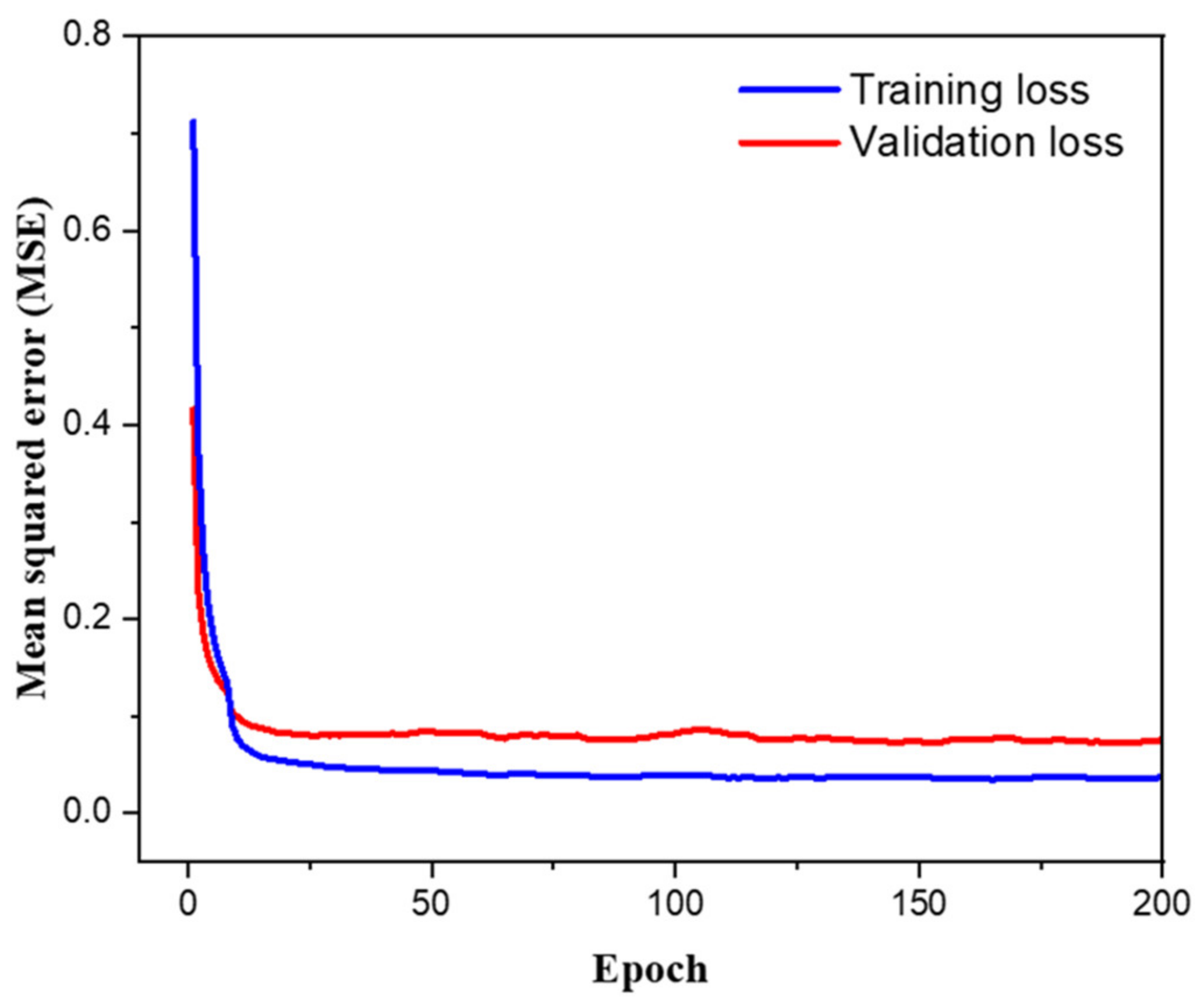
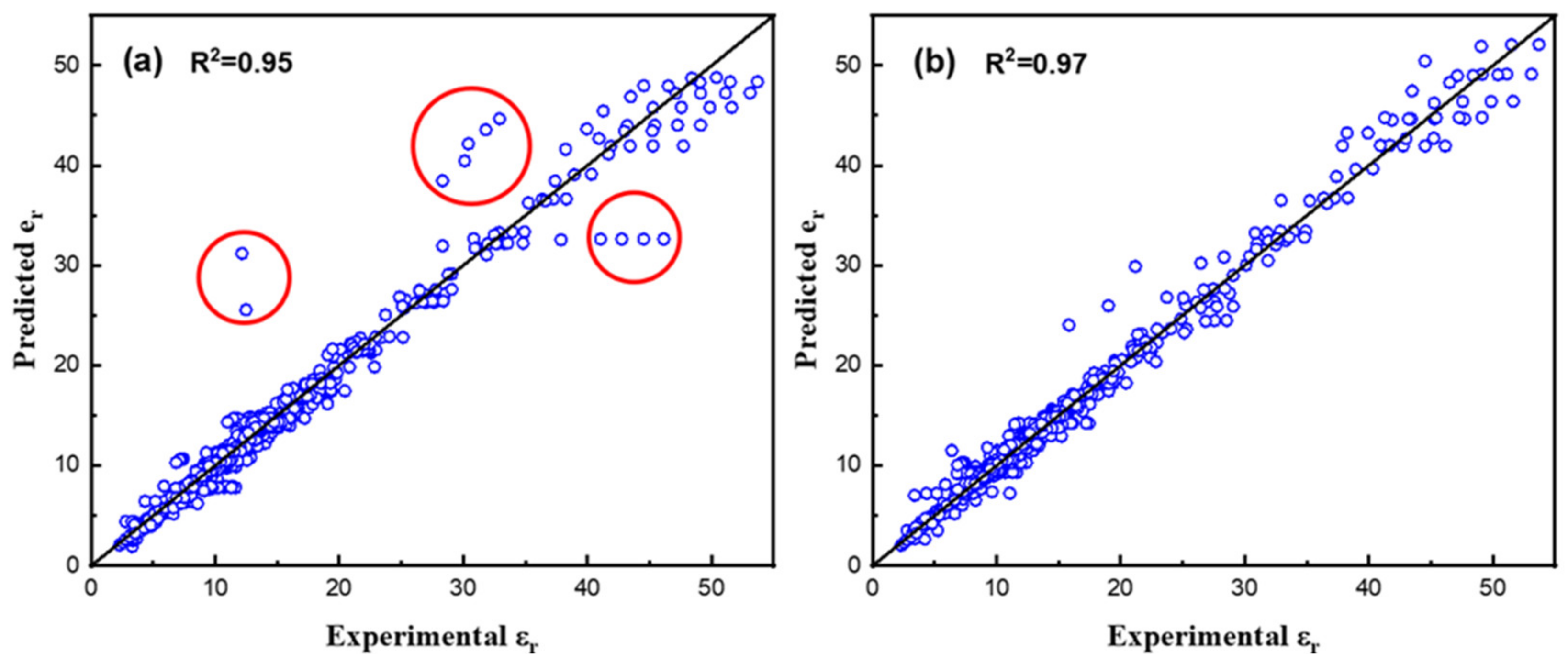

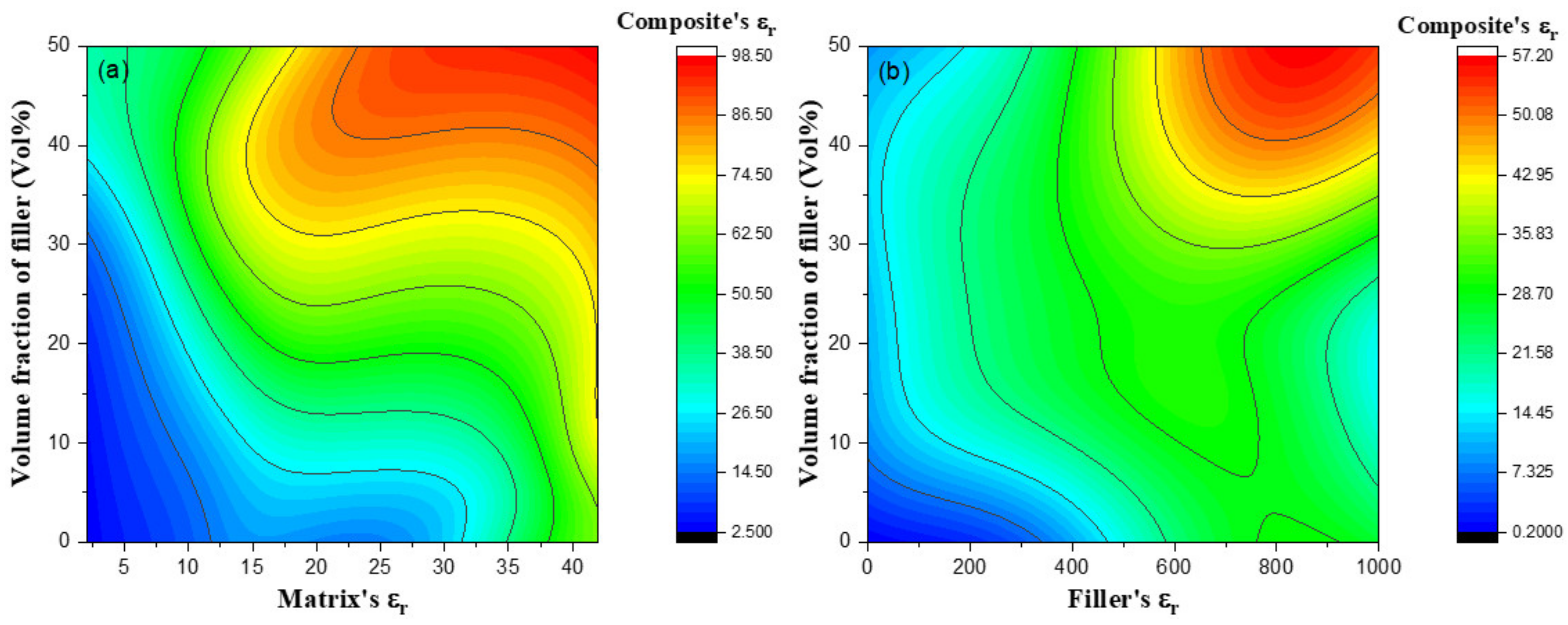
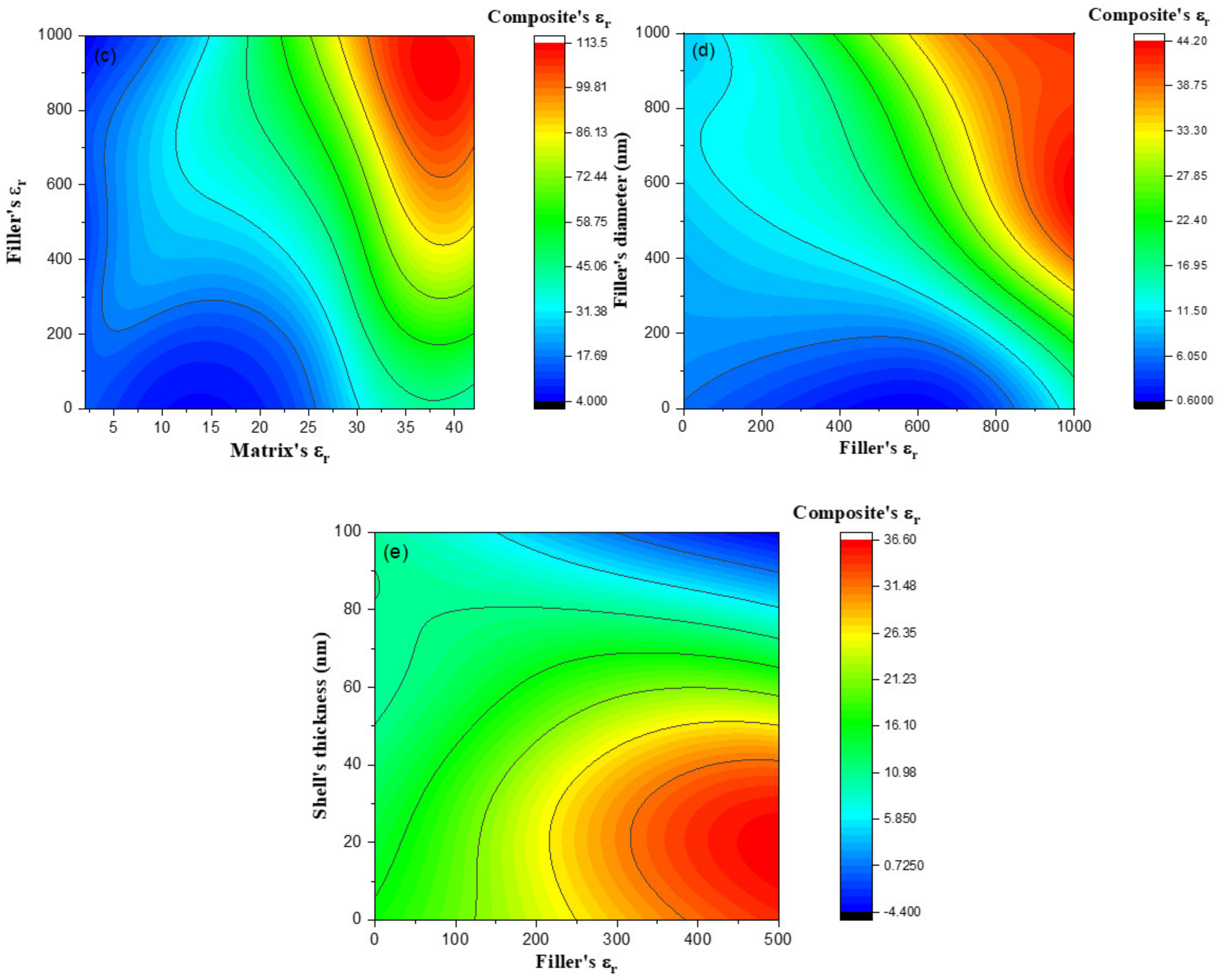

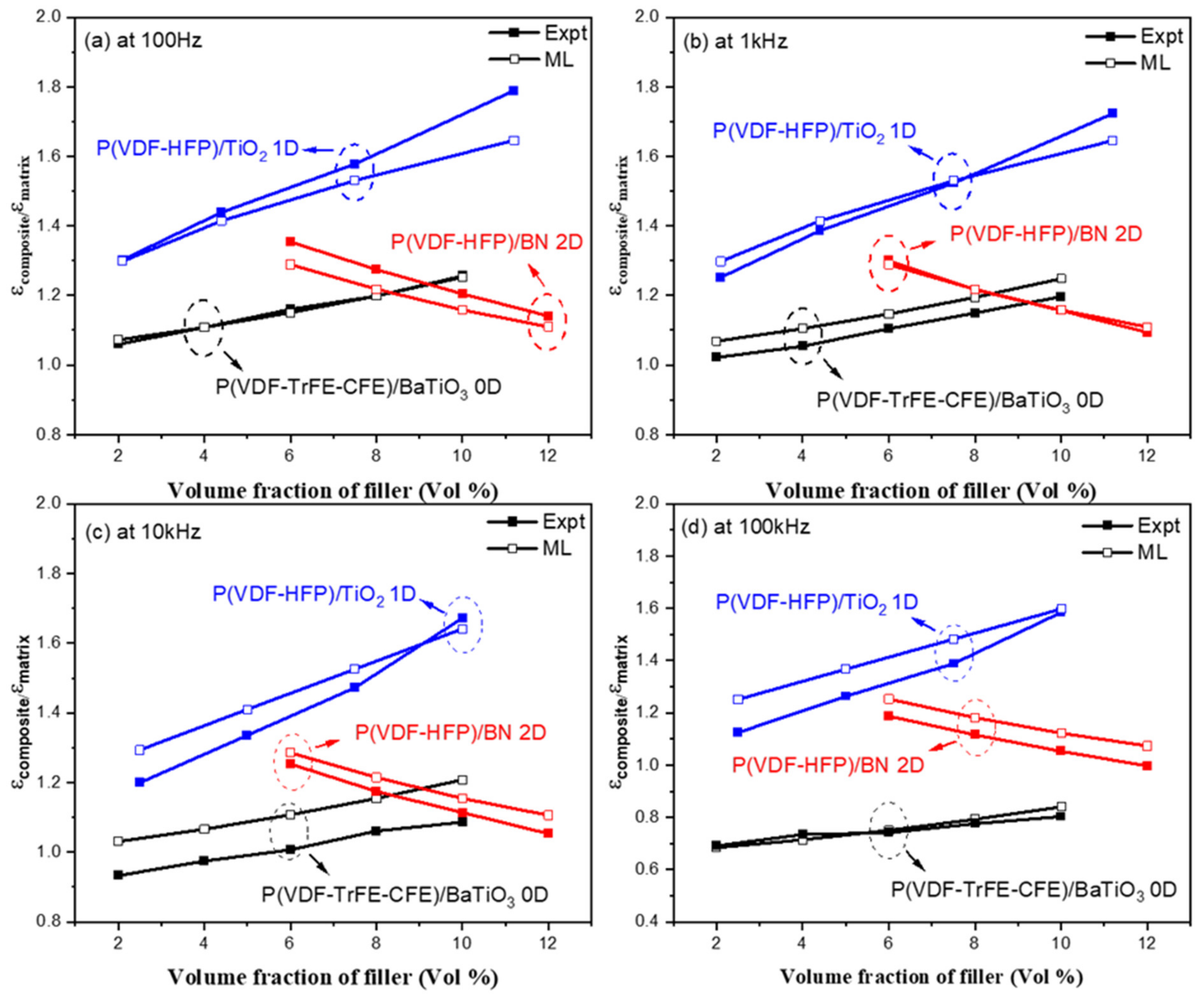
| Matrix | Dielectric Constant | Filler | Dielectric Constant |
|---|---|---|---|
| Polypropylene, (PP) | 2.1 | BNNS | 4 |
| Polyimide, (PI) | 3.2 | Al2O3 | 9.4 |
| Poly(vinylidene fluoride-co-hexafluoropropylene), P(VDF-HFP) | 8.4 | TiO2 | 110 |
| Polyvinylidene fluoride, (PVDF) | 8.6 | NaNbO3 | 200 |
| Poly(vinylidene fluoride-trifluoroethylene), P(VDF-TrFE) | 12 | SrTiO3 | 200 |
| Poly(vinylidene fluoride-co -chlorotrifluoroethylene, P(VDF-CTFE) | 12.3 | BaSrTiO3 | 300 |
| Poly(vinylidene fluoride-trifluoroethylene-chlorofluoroethylene), P(VDF-TrFE-CFE) | 41 | BaTiO3 | 1000 |
| Poly(vinylidene fluoride-trifluoroethylene-chlorotrifluoroethylene), P(VDF-TrFE-CTFE) | 42 |
| Ranking | 1 | 2 | 3 | 4 | 5 | |
|---|---|---|---|---|---|---|
| No. of hidden layers | 4 | 3 | 2 | 4 | 3 | |
| No. of nodes | Layer 1 | 48 | 64 | 32 | 48 | 48 |
| Layer 2 | 32 | 64 | 32 | 48 | 32 | |
| Layer 3 | 32 | 48 | 32 | 32 | ||
| Layer 4 | 16 | 16 | ||||
| Learning rate | 0.001 | 0.001 | 0.001 | 0.01 | 0.001 | |
| Mean squared error | 0.1372 | 0.1384 | 0.1416 | 0.1429 | 0.1431 | |
Publisher’s Note: MDPI stays neutral with regard to jurisdictional claims in published maps and institutional affiliations. |
© 2022 by the authors. Licensee MDPI, Basel, Switzerland. This article is an open access article distributed under the terms and conditions of the Creative Commons Attribution (CC BY) license (https://creativecommons.org/licenses/by/4.0/).
Share and Cite
Ji, S.; Jeong, D.-Y.; Kim, C.; Yi, S. High Dielectric Design of Polymer Composites by Using Artificial Neural Network. Appl. Sci. 2022, 12, 12592. https://doi.org/10.3390/app122412592
Ji S, Jeong D-Y, Kim C, Yi S. High Dielectric Design of Polymer Composites by Using Artificial Neural Network. Applied Sciences. 2022; 12(24):12592. https://doi.org/10.3390/app122412592
Chicago/Turabian StyleJi, Sungyub, Dae-Yong Jeong, Cheolhee Kim, and Sung Yi. 2022. "High Dielectric Design of Polymer Composites by Using Artificial Neural Network" Applied Sciences 12, no. 24: 12592. https://doi.org/10.3390/app122412592






